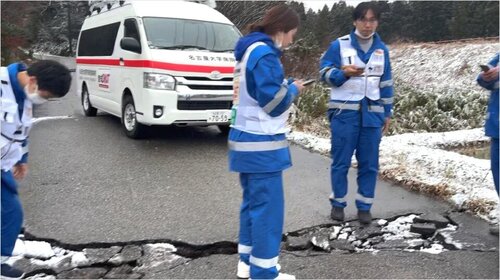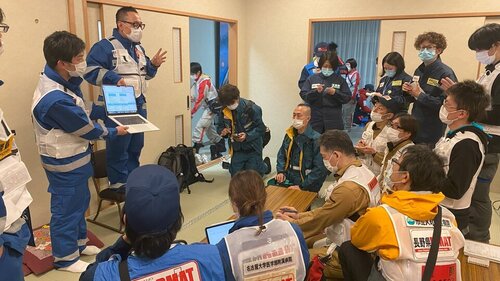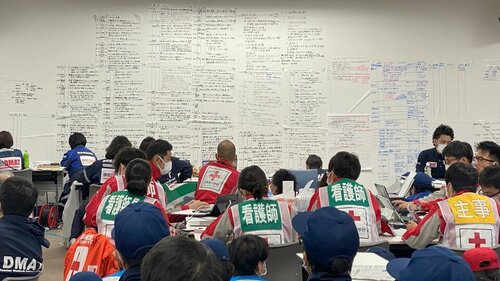Even three months (at the time of writing) after the 2024 Noto Earthquake, whose 7.6 magnitude and six-metre tsunami devastated parts of Ishikawa Prefecture, over six thousand people remained stranded in evacuation centers, unable to return home. Since January, the Nagoya University Hospital Disaster Medical Assistance Team (DMAT) has visited the area twice. The DMAT team's seven members - one doctor, a radiographer, three nurses and two pharmacists - kindly gave their time to talk to us about their experiences in the disaster zone.
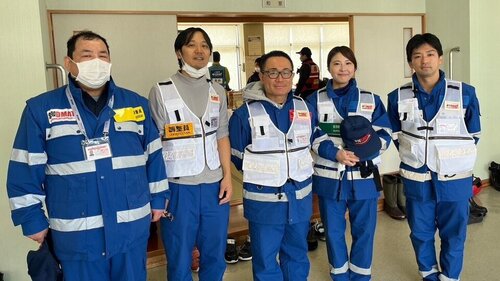
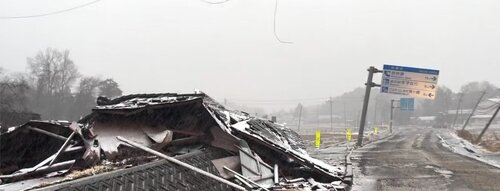 The Nagoya University DMAT team (above) and the scenes that greeted them on the way to Suzu (below)
The Nagoya University DMAT team (above) and the scenes that greeted them on the way to Suzu (below)
Their first visit on January 4-8, just three days after the earthquake struck, was to the city of Suzu, which was hit by a four metre tsunami. What they found was a care system struggling to survive in the wake of disaster.
Their destination, which they struggled to access on roads blocked by fallen trees, landslides and subsided buildings, was a residential care facility for the elderly located near the tip of the Noto Peninsula, which stretches out from Ishikawa Prefecture into the Sea of Japan.
The second floor was unusably damaged, and electricity, gas and water supplies were cut off, leaving residents and staff unable to use heating or even toilets. Mats were laid down in the lobby and corridors, residents huddled together in the cold.
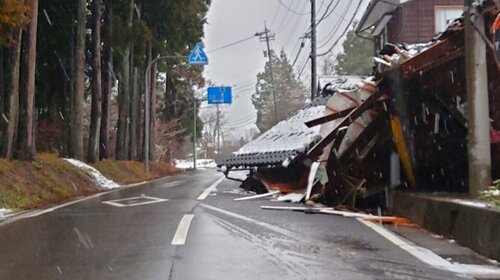 The team had to navigate around collapsed roads and buildings
The team had to navigate around collapsed roads and buildings
Stuck in this hellish situation were a hundred residents of the elderly care facility, joined by a further twenty evacuees from a nearby group home for people with developmental disabilities. The majority of the ninety staff were unable to make it to work, and the thirty who could had all dealt with damage to or collapse of their own homes. These remaining staff had spent the period since the earthquake working mostly without sleep in almost unbearable conditions.
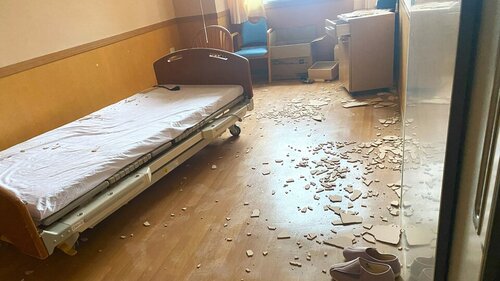 A damaged room at the care facility
A damaged room at the care facility
Upon their arrival, the DMAT team asked the staff to explain their situation to them. Far away from any urban center, they had yet to receive any help, support or information, with their feeling of isolation growing stronger every day. "We really wondered if we had been left behind," they said candidly, unable to hide their distress.
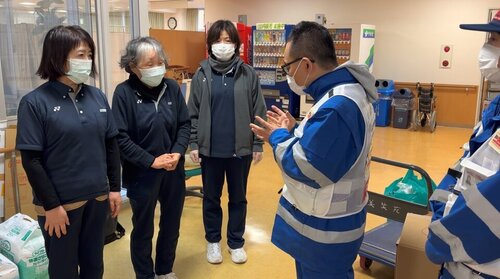 The DMAT team speak with staff at the facility
The DMAT team speak with staff at the facility
"After 7 days working with little to no rest, it was clear that they were mentally and physically exhausted. It was important that we listened to what they had to tell us," reflects Dr Takanori Yamamoto, leader of the DMAT team.
Nurse Chie Ebisudani agrees: "It was less them asking us to come and help with caring for the residents, and more a desire to be heard and have their feelings and situation understood."
While the majority of disaster relief medicine is emergency care of the injured and acutely sick, the Nagoya University DMAT team's task this time was to manage the risk of the breakdown of the care system. "People in need of round the clock nursing care, such as those who are bed-bound, have their lives put in danger the moment that a natural disaster renders them unable to receive the care that they need," explains Dr Yamamoto.
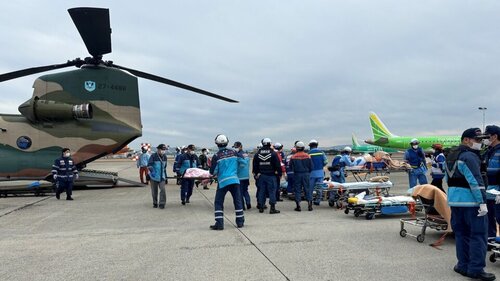 Evacuees boarding helicopters leaving the disaster zone
Evacuees boarding helicopters leaving the disaster zone
Based on their first visit to the care facilities in Suzu, the Nagoya University DMAT team recommended to the DMAT headquarters that, based on the imminent threat to life posed by the breakdown of the system in the wake of the disaster, the residents should be evacuated to a location where they could be properly cared for. As a result, Self Defence Forces helicopters arrived to conduct the evacuation on January 11. "This was the first time such a large-scale evacuation of nursing care recipients, as opposed to critically injured or sick patients, had ever been carried out," says Dr Yamamoto.
The Nagoya University DMAT team also took on the role of organizing the 'base camp', the central location where DMAT teams from around the country had gathered, and finding out what kind of help was needed where. They processed requests for emergency medical assistance and incoming information about the location and numbers of evacuees, and assigned tasks to the other teams.
Their second visit to the disaster zone came one month after the earthquake, January 31 - February 2. This time, the Nagoya University team's job was to handle the departure of the other DMAT teams' departure from the area and the handing back to local medical services of their operations.
At the DMAT 'base camp' in Wajima
On February 26, ¥2,880,000 raised by the Nagoya University community was donated to aid organizations helping people recover from the effects of the earthquake. Nagoya University hosts one of the country's biggest disaster prevention research centers and continues to work towards building a future in which people's lives will be less disrupted by the earthquakes which impact Japan so regularly.

